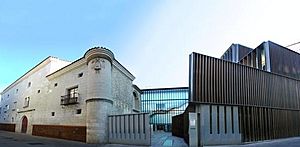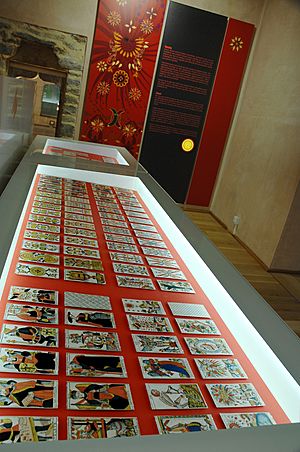Fournier Museum of Playing Cards facts for kids
Quick facts for kids Fournier Museum of Playing Cards |
|
|---|---|
| Native name Spanish: Museo Fournier de Naipes de Álava |
|
 |
|
| Location | Cuchilleria, 54 01001 Vitoria-Gasteiz, Spain |
| Website | official website: https://fourniermuseoabibat.eus/es/inicio |
| Official name: Museo Fournier de Naipes de Álava | |
| Type | Non-movable |
| Criteria | Monument |
| Designated | 1984 |
| Reference no. | RI-51-0005128 |
| Lua error in Module:Location_map at line 420: attempt to index field 'wikibase' (a nil value). | |
The Fournier Museum of Playing Cards (in Spanish: Museo Fournier de Naipes de Álava) is a super cool museum in Vitoria, Spain. It's all about playing cards! Imagine seeing cards from hundreds of years ago. This museum started as a private collection in 1916. It was owned by Félix Alfaro Fournier, whose family made playing cards.
Later, the government of Álava bought this amazing collection. In 1984, it was even declared a special protected site. In 1994, the museum moved to its current home. It's now in a beautiful old building called the Bendaña Palace. The museum shares this palace with the Álava Museum of Archaeology.
The Museum's Home: Bendaña Palace
The Fournier Museum of Playing Cards is inside the amazing Bendaña Palace. This palace is a very old building. It was built way back in the early 1500s! That's over 500 years ago. A person named Juan López de Arrieta had it built in 1525. It stands where an old medieval tower used to be.
Even though it was built during the Renaissance period, you can still see some older Gothic style parts. For example, the main entrance on Cuchilleria Street has a pointed arch. Inside, the stairs have a cool star-shaped ceiling. The palace's courtyard is a great example of Renaissance style. It has three floors with open arched walkways.
What Can You See at the Museum?
The collection at the Fournier Museum of Playing Cards began in 1916. Félix Alfaro Fournier started it. He took over the family's playing card factory after his grandfather, Heraclio Fournier González, passed away.
In 1984, the government of Álava bought the collection. At that time, it had about 3,400 decks of cards! They first showed these cards at the Fine Arts Museum of Álava. The collection kept growing, so they needed more space. That's why it moved to the Bendaña Palace in 1994.
This museum is special because there are not many museums in the world just for playing cards. It has a huge collection. The museum's main display shows a small part of its more than 20,000 decks of cards. These cards come from many different countries. You can find cards from all five continents!
The Fournier Museum of Playing Cards takes you on a journey through time. You can see how playing cards have changed from the 1400s until today. Besides card decks, the museum also shows old machines. You can see other tools that were used to make playing cards throughout history.
See also
 In Spanish: Museo Fournier de Naipes para niños
In Spanish: Museo Fournier de Naipes para niños



